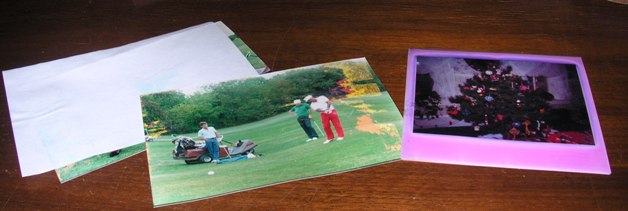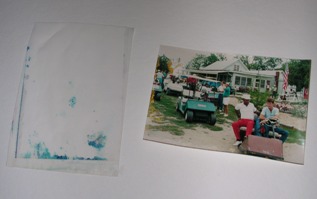Monday, January 12, 2009
 These photographs were found among the documents from the African American Museum that were returned from the freeze dryer. This is one example of many envelopes full of photographs. These photographs were interleaved with sheets of archival paper which were adhered to the photographs when they were immersed by the flood. At a glance it looked like there was little hope of removing the paper from the pictures without damaging them.
These photographs were found among the documents from the African American Museum that were returned from the freeze dryer. This is one example of many envelopes full of photographs. These photographs were interleaved with sheets of archival paper which were adhered to the photographs when they were immersed by the flood. At a glance it looked like there was little hope of removing the paper from the pictures without damaging them.
 We took a couple of examples to the University of Iowa Photo Department where we were advised to try and wet the photos again to remove the paper. When we returned to the Conservation lab I put one of the photos in a bath of water with photoflo and left it there for about ten minutes. When I came back the paper had floated off and the photo had sunk to the bottom of the tray. As you can see, some of the emulsion adhered to the interleaving but the pictures are mostly intact.
We took a couple of examples to the University of Iowa Photo Department where we were advised to try and wet the photos again to remove the paper. When we returned to the Conservation lab I put one of the photos in a bath of water with photoflo and left it there for about ten minutes. When I came back the paper had floated off and the photo had sunk to the bottom of the tray. As you can see, some of the emulsion adhered to the interleaving but the pictures are mostly intact.
I then let the photos drain vertically for a few minutes to get most of the water off so there wouldn’t be droplets and puddles on them when they were set out to dry. I set them out on our drying rack and let them dry overnight. In the morning I found them to be warped and curling which was to be expected after the aqueous treatment. I put the photos in between sheets of silicon release paper and put them in the dry mount press under medium heat. I left them for about 15 minutes and they came out almost perfectly flat. I then left them under weight for 24 hours and they are now perfectly flat.
If there had been no interleaving, these photographs would have been cemented together, never to be separated and none of this would have been possible. Thanks to the good preservation practices of this museum this photo collection will be salvaged.